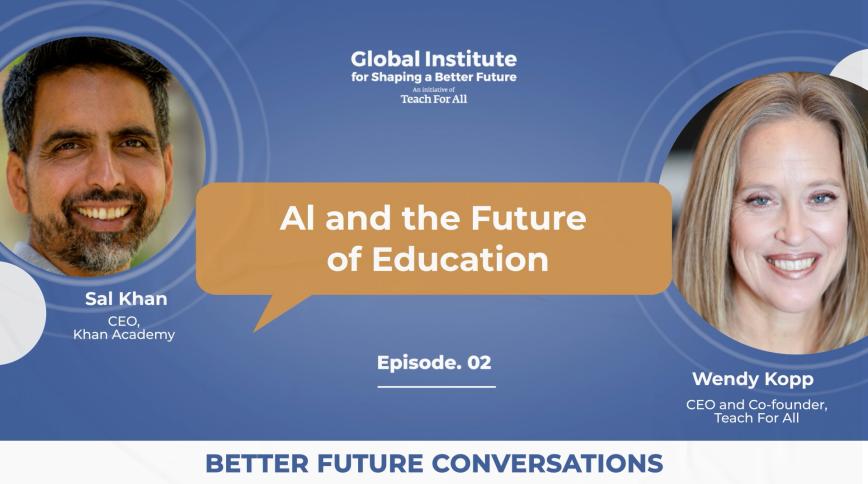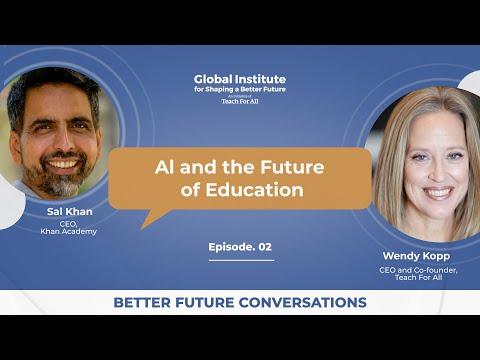Better Future Conversations: AI and the Future of Education

In the second episode of Better Future Conversations, we explored the question of Artificial intelligence and the future of education with Sal Khan, who has long grappled with questions at the intersection of learning and technology. Through Khan Academy and the recent Khanmigo AI tutor, he has spent years designing tools that make learning more personal and effective.
The advancement of AI has left many parents, educators, and students with questions. Will AI support or diminish students’ ability to think deeply and independently? Will teachers still matter? Will AI help close equity gaps, or make them even wider? How do we help young people thrive in a world shaped by technology?
Through Better Future Conversations, we are stepping back to ask what it will take to reshape education to develop students who can shape a better future for themselves and all of us. We are bringing together thought leaders from around the world whose experience and perspectives can help catalyse and develop our collective thinking about what it will take.
In my conversation with Sal, we discussed the rapid acceleration of AI, its risks and opportunities, and how we can ensure that education nurtures the agency and leadership of students. I was reminded that, even, and especially, in this moment of rapid technological change, it is important to strengthen our focus on what should be: to prepare young people to shape their lives and the world for the better.
What AI Will Change–and What It Won’t
Artificial intelligence is already capable of doing many of the things we once trained students to do: writing essays, solving math problems, and even generating computer code. But Sal, as one of the world’s strongest proponents of technology in education, urged us to recognize that this does not diminish the need for students to learn these skills, and in fact, makes it even more important that they master them. As Sal noted, just as calculators most empower those who already know arithmetic, AI most benefits those with strong foundational skills and deep knowledge.
On the other hand, Sal believes that what AI will shift is what we measure. Historically, because standardised testing could capture only a narrow set of skills, schools and teachers often focused on rote memorisation and cognitive knowledge at the expense of students’ holistic development. But AI will enable assessments that don’t just ask students to fill in bubbles, but rather to give a speech, collaborate in a simulation, create a design, or work through a problem in real time, helping teachers capture and evaluate those outcomes. This opens the possibility of valuing creativity, collaboration, leadership, resilience, and other capacities that truly matter for life, work, and human connectedness. If AI can broaden what we measure, it can help us reorient education toward holistic student development and the human capabilities the world most needs. As Sal put it, the very skills we’ve called “soft” could finally get the attention they deserve, because we’ll have tools to assess them more reliably, unlock the full potential of every student, and better prepare them for the complexity of the world ahead.
Keeping Students at Their Learning Edge
We all learn best when we are working at our “learning edge”—challenged enough to stretch, but not so much as to feel lost. The learning edge is the point at which active learning occurs, where a learner is challenged to push their understanding beyond their current capabilities. Yet in most classrooms today, students spend surprisingly little time at this edge.
Sal shared research showing that as little as 60 minutes a week of truly personalized, focused practice can accelerate learning by 30–50%. Why? Because when learning is personalized through technology, peer-to-peer engagement, or targeted practice, students are far more likely to experience the flow of being right at their edge, building both confidence and agency.
AI can play a powerful role here. By analyzing student work and providing immediate feedback, it can help ensure that more students spend more time at their learning edge. And by freeing up teacher time, it can allow for more one-on-one moments where teachers can connect with students, diagnose challenges, and offer encouragement. The promise is not just better academic outcomes, but young people who experience learning as active, meaningful, and within their own control.
The Irreplaceable Role of Teachers
Perhaps the clearest message from my conversation with Sal is that teachers have never been more important.
AI may automate routine tasks—grading, generating lesson plans, and administrative paperwork—but it cannot replace the human work of building relationships, sparking curiosity, or helping a child feel seen and believed in.
As Sal shared, effective teaching is fundamentally about engagement. A motivated student can learn even from a 19th-century textbook; an unmotivated one may disengage even with the most advanced technology. Teachers are the ones who create the conditions for engagement.
And technology helps their role shift from “sage on the stage” to co-learners alongside students, modeling what it means to navigate an uncertain world with curiosity and humility.
Facing the Risks of AI
Even as we imagine the possibilities, we must face the risks that AI in education poses:
Equity: Without deliberate effort, AI could widen gaps between the privileged and the marginalized. Students in under-resourced communities risk being left behind without reliable connectivity, access to devices, or teachers trained to integrate these tools. At the same time, AI has real potential to increase access. Features like automatic translation, real-time captions, and voice-to-text can open doors for students with disabilities and for those who speak less-resourced languages.
Mental Health & Safety: The social media era has shown us how seemingly harmless tools can erode well-being and civic trust. AI could have similar unintended consequences. Already, we’ve seen examples of AI giving harmful responses to vulnerable young people. On the other hand, Sal shared a personal story about his daughter journaling with ChatGPT and being gently reminded to value her relationship with her younger brother. AI can play a positive role, too, but only if we prioritize child safety, accountability, thoughtful design, and strong guardrails.
Cheating & Academic Integrity: AI makes it easier for students to bypass the hard work of deep learning. But as Sal emphasized, the real question is not “How do we catch cheaters?” but “What are we truly trying to teach and assess?” If the goal is to structure thoughts, synthesise ideas, or conduct research, assignments must be reimagined. Some learning should happen transparently with AI as a partner, since that reflects real-world skills. Other times, more in-class work can help ensure that what we’re seeing is a student’s true learning process, not just a polished output.
The rise of AI challenges us to rethink nearly every aspect of teaching and learning. If we hold firm to the purpose of education—preparing young people to thrive and to lead in shaping a better future—then AI can become a catalyst. This will require us to confront risks honestly, to equip teachers and students to use these tools wisely, and to center relationships, agency, and equity in all we do. If we succeed, we may look back on this moment as the time when education finally shifted toward cultivating the full humanity of every student, with technology serving as a partner in that transformation.
Stay Connected
This conversation is part of Better Future Conversations, an ongoing space featuring thought leaders from all over the world who can advance our collective thinking.
We’d love to stay connected. Sign up to receive updates and join us live for the next episode.
